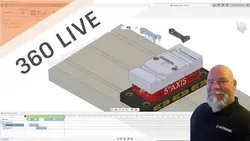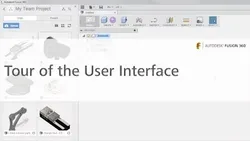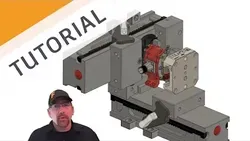
Engineering Design Process with Autodesk Fusion 360

Get a comprehensive overview of Engineering Design Process with Autodesk Fusion 360▼
Course Feature
![]() Cost:
Cost:
Free
![]() Provider:
Provider:
Coursera
![]() Certificate:
Certificate:
Paid Certification
![]() Language:
Language:
English
![]() Start Date:
Start Date:
17th Jul, 2023
Course Overview
❗The content presented here is sourced directly from Coursera platform. For comprehensive course details, including enrollment information, simply click on the 'Go to class' link on our website.
Updated in [March 06th, 2023]
This course provides a comprehensive overview of the engineering design process with Autodesk Fusion 360. Learners will gain an understanding of the trends that are influencing the design industry, and develop the skills to use more advanced CAD and simulation tools. Through exploration and iteration, learners will be able to test and improve design components and performance, and come closer to a final design. With the help of Fusion 360 tutorials and training, learners will be able to create 3D models, use engineering design tools, and gain a deeper knowledge of Autodesk Fusion 360. This course is ideal for those looking to gain Autodesk Fusion 360 certification.
[Applications]
Upon completion of this course, learners will be able to apply the engineering design process and workflow in Autodesk Fusion 360 to their own projects. They will be able to use the advanced CAD and simulation skills they have learned to test and improve design components and performance. Learners can also take advantage of additional learning resources to help them uplevel their skills and prepare for Autodesk Fusion 360 certification.
[Career Paths]
1. Mechanical Engineer: Mechanical engineers use Autodesk Fusion 360 to design and develop mechanical systems, components, and products. They use the software to create 3D models, analyze performance, and simulate the behavior of mechanical systems. This job is in high demand due to the increasing complexity of mechanical systems and the need for more efficient and cost-effective solutions.
2. Design Engineer: Design engineers use Autodesk Fusion 360 to create and develop innovative products and components. They use the software to create 3D models, analyze performance, and simulate the behavior of products. This job is in high demand due to the increasing complexity of products and the need for more efficient and cost-effective solutions.
3. Manufacturing Engineer: Manufacturing engineers use Autodesk Fusion 360 to design and develop manufacturing processes and systems. They use the software to create 3D models, analyze performance, and simulate the behavior of manufacturing systems. This job is in high demand due to the increasing complexity of manufacturing processes and the need for more efficient and cost-effective solutions.
4. Simulation Engineer: Simulation engineers use Autodesk Fusion 360 to create and develop simulations of mechanical systems and products. They use the software to create 3D models, analyze performance, and simulate the behavior of mechanical systems. This job is in high demand due to the increasing complexity of mechanical systems and the need for more accurate and reliable simulations.
[Education Paths]
1. Mechanical Engineering: Mechanical engineering is a field of engineering that focuses on the design, development, and production of machines and mechanical systems. It is one of the oldest and broadest engineering disciplines, and it is a rapidly growing field due to the increasing demand for automation and robotics. Mechanical engineers are in high demand in the automotive, aerospace, and manufacturing industries, and they are also involved in the development of medical devices, energy systems, and consumer products. The development of new technologies such as 3D printing and additive manufacturing is also driving the growth of mechanical engineering.
2. Industrial Design: Industrial design is a field of engineering that focuses on the design and development of products and services. Industrial designers use their knowledge of materials, manufacturing processes, and design principles to create products that are both aesthetically pleasing and functional. Industrial designers are in high demand in the automotive, consumer electronics, and medical device industries, and they are also involved in the development of furniture, toys, and other consumer products. The development of new technologies such as virtual reality and augmented reality is also driving the growth of industrial design.
3. Computer-Aided Design (CAD): Computer-aided design (CAD) is a field of engineering that focuses on the use of computer software to create and modify designs. CAD is used in a variety of industries, including automotive, aerospace, and manufacturing. CAD is used to create detailed drawings and models of products, and it is also used to simulate and analyze product performance. The development of new technologies such as 3D printing and additive manufacturing is also driving the growth of CAD.
4. Robotics: Robotics is a field of engineering that focuses on the design, development, and operation of robots. Robotics is used in a variety of industries, including automotive, aerospace, and manufacturing. Robotics is used to automate processes and tasks, and it is also used to develop autonomous systems. The development of new technologies such as artificial intelligence and machine learning is also driving the growth of robotics.
Pros & Cons
-

Good content and managed to develop intermediate skills in Fusion 360.
-

Worth taking this course if you are interested in Engineering Design.
-

Good understanding of quadcopter and structure thinkings.
-

Discussion forum becomes inactive after the week.
-

Repetitive topics from previous courses.
-

Assignment evaluation not taken seriously.
-

Time consuming searching for components.
Course Provider






